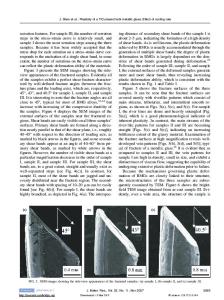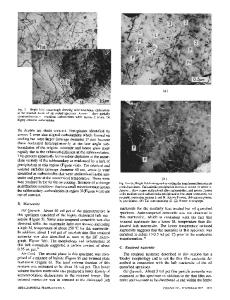Influence of Cooling Rate on the Enthalpy Relaxation and Fragility of a Metallic Glass
- PDF / 418,093 Bytes
- 5 Pages / 593.972 x 792 pts Page_size
- 33 Downloads / 310 Views
TRODUCTION
STRUCTURAL relaxation of a glass is a process in which short-range atomic rearrangements take place to account for the evolution of the as-cast property of the glass toward its equilibrium value, when annealed below Tg. The process of structural relaxation occurs in all classes of glasses, including oxide and polymeric glasses.[1] The ‘‘frozen-in’’ free volume is considered as the primary ‘‘flow defect’’ that accounts for diffusion in metallic glasses.[2] It is now well accepted that a higher cooling rate will entrap larger amounts of free volume.[3–5] A slower cooling rate entraps lesser free volume but allows significant short-range ordering. Prior studies have shown that the free volume is sensitive to the structural relaxation anneals. Free volume controls the shear localization and plasticity at low temperatures, which influences the impact toughness and wear resistance of metallic glasses.[6–8] Thus, it is imperative to develop a detailed understanding of the structural relaxation kinetics in these materials. While the relaxation behavior of rapidly quenched glasses (RQGs) is widely studied and reported in the literature, the slowly cooled glasses–so-called bulk metallic glasses (BMGs)—are not that critically examined. In particular, there is a paucity of information that compares RQG and BMG relaxation glasses, which is the objective of R. RAGHAVAN and P. MURALI, Research Students, and U. RAMAMURTY, Associate Professor, are with the Department of Materials Engineering, Indian Institute of Science, Bangalore 560012, India. Contact e-mail: [email protected] This article is based on a presentation given in the symposium entitled ‘‘Materials Behavior: Far from Equilibrium’’ as part of the Golden Jubilee Celebration of Bhabha Atomic Research Centre, which occurred December 15–16, 2006 in Mumbai, India. Article published online August 10, 2007 METALLURGICAL AND MATERIALS TRANSACTIONS A
this study. In this context, it is worth noting that some studies were reported recently comparing the deformation behaviors of a RQG and BMG of the same composition and imply subtle differences.[3–5,9]
II.
MATERIALS AND EXPERIMENTS
An alloy of nominal composition Pd40Cu30Ni10P20 (at. pct) was melted in a vacuum induction furnace with back-filled argon gas and then was cast in a watercooled copper mold in the form of a 10 mm diameter rod. Ribbons of the same composition were obtained by melt spinning at a wheel speed of 40 m/s. The amorphous nature of the as-cast alloys was ascertained by X-ray diffraction (XRD) and transmission electron microscopy. The bulk alloy was isothermally annealed at 523 K (note Tg = 573 K) for different times. The ribbon samples were annealed at 523 K as well as 483 K. Prior to the heat treatment, the samples were vacuum sealed in quartz tubes to a pressure of 10–6 MPa to avoid oxidation and a low-temperature resistance-heating furnace with a heating rate of approximately 0.083 K/s was used for the annealing. The annealed samples were cooled to room temperature within the furnace by switch
Data Loading...











